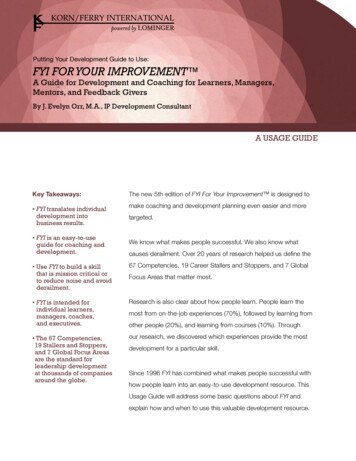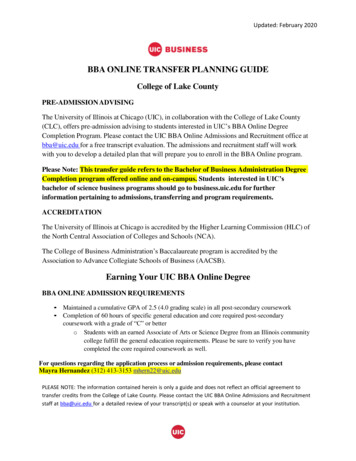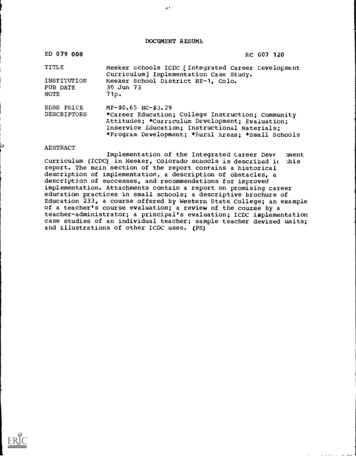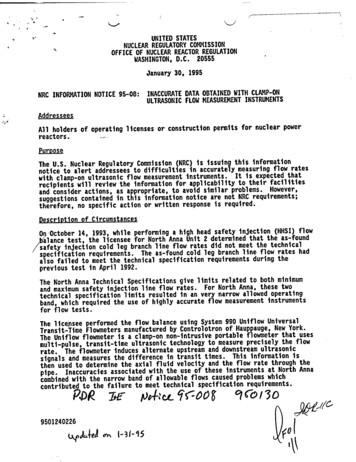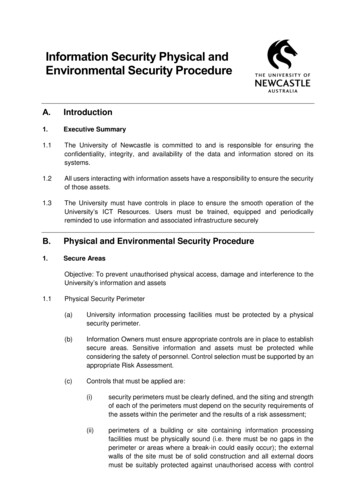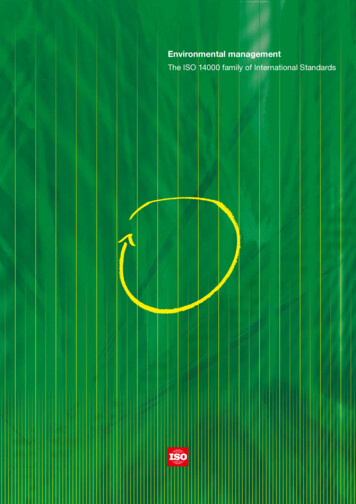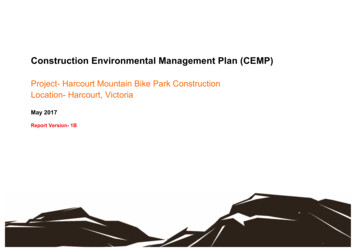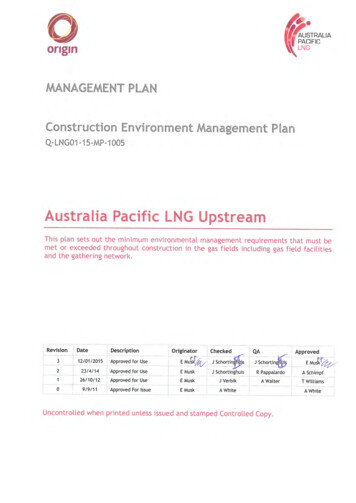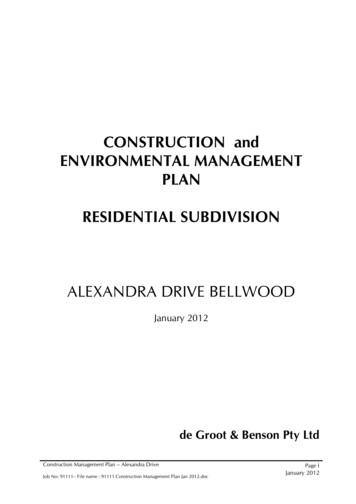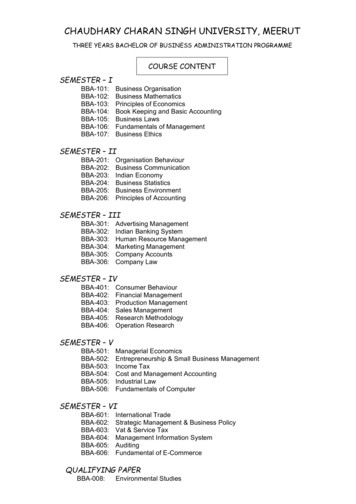
Transcription
CHAUDHARY CHARAN SINGH UNIVERSITY, MEERUTTHREE YEARS BACHELOR OF BUSINESS ADMINISTRATION PROGRAMMECOURSE CONTENTSEMESTER – BA-107:Business OrganisationBusiness MathematicsPrinciples of EconomicsBook Keeping and Basic AccountingBusiness LawsFundamentals of ManagementBusiness EthicsSEMESTER – Organisation BehaviourBusiness CommunicationIndian EconomyBusiness StatisticsBusiness EnvironmentPrinciples of AccountingSEMESTER – :Advertising ManagementIndian Banking SystemHuman Resource ManagementMarketing ManagementCompany AccountsCompany LawSEMESTER – Consumer BehaviourFinancial ManagementProduction ManagementSales ManagementResearch MethodologyOperation ResearchSEMESTER – anagerial EconomicsEntrepreneurship & Small Business ManagementIncome TaxCost and Management AccountingIndustrial LawFundamentals of ComputerSEMESTER – International TradeStrategic Management & Business PolicyVat & Service TaxManagement Information SystemAuditingFundamental of E-CommerceQUALIFYING PAPERBBA-008:Environmental Studies
CHAUDHARY CHARAN SINGH UNIVERSITY, MEERUTTHREE YEARS BACHELOR OF BUSINESS ADMINISTRATION PROGRAMMECOURSE CONTENT FOR SEMESTER – IBBA-101:BUSINESS ORGANISATIONUnit – I: Meaning and definition of business essentials & scope of business ClassificationUnit – II: Business Unit, Establishing a new business unit. Meaning of Promotion. FeaturesUnit – III: Forms of Business Organisation. Sole Proprietorship, Partnership, Joint StockUnit – IV: Business Combination Meaning Causes, Objectives, Types and Forms Mergers,Unit – V: Business Finance: Financial need of Business methods & sources of finance. Securityof Business Activities, Meaning, Definition, Characteristics and objectivesof Business Organisation, Evolution of Business Organisation . Modern Business,Business & Profession.for business, Plant location, Plant Layout & size of business unit.Companies & Co-operatives.Takeovers and Acquisitions.Market, Money Market, Study of Stock Exchange & SEBI.Suggested Readings:1. Chottorjee S.K. Business Organisation2. Jagdish Prakash Business Organistaton and Management3. Om Prakash Business Organisation4. Sherlekar S.A. Business Organisation and Management5. Singh & Chhabra Business Organisation
BBA-102: BUSINESS MATHEMATICSUnit – I: Matrix: Introduction, Square Matrix, Row Matrix, Column Matrix, DiagonalUnit – II: Inverse of Matrix, Rank of Matrix, Solution to a system of equation by theUnit – III: Percentage, Ratio and Proportion, Average, Mathematical Series-Arithmetic,Unit – IV: Set theory- Notation of Sets, Singleton Set, Finite Set, Infinite Set, Equal SetUnit – V: Concept of Differentiation and Integration, Maxima and Minima inMatrix, Identity Matrix, Addition, Subtraction & Multiplication of Matrix, Useof Matrix in Business Mathematical Inductionadjoint matrix methods & Guassian Elimination Method.Geometric & Harmonic, Simple Interest & Compound Interest.Null Set, Subset, Proper Subset, Universal Set, Union of Sets, Inter-section ofSets, Use of set theory in business, Permutation & CombinationDifferentiation, Application of Differentiation & Integration in Business(No proof of theorems. Etc)Suggested Readings:1. Mehta & Madnani Mathematics for Economics2. Mongia Mathematics for Economics3. Zamiruddin Business Mathematics4. Raghavachari Mathematics for Management
BBA-103: PRINCIPLES OF ECONOMICSUnit – I: Definition, Nature, Scope & Limitation of Economics as an art or Science.Unit – II: Meaning of demand. Demand theory and objectives, Demand analysis.Unit – III: Production-Meaning and Analysis Production function. Laws of production,Unit – IV: Market analysis-Nature of market, Types of markets and their characteristicsUnit – V: Theories of factor pricing, factor pricing v/s product pricing. Theories of rentRelevance of Economics in Business Management, Utility analysis, MarginalTheory of utilities and Equi-Marginal theory of utility.Demand schedule. Demand Curve and Nature of Curves, Laws of DemandElasticity of Demand Types & Measurement, Indifference curves analysisConsumer Equilibrium & Consumer Surplus. Price, Income andsubstitution effect.Laws of increasing returns & Laws of constant returns. Equal product curvesand Producer equilibrium.Pricing under different market structures-Perfect Monopoly, oligopoly andMonopolistic completion. Price discrimination under monopoly competition.theories of interest theories of wages theories of profit, Concept of profitmaximizationSuggested Readings:1. Adhjkari M Management Economics2. Gupta G.S. Managerial Economics3. Lal S.M. Principles of Economics4. Vaish & Sunderm Principles of Economics
BBA-104: BOOK KEEPING AND BASIC ACCOUNTINGUnit – I: MeaningUnit – II: AccountingUnit – III: Rectification of errors preparation of bank reconciliation Statement, Bills ofUnit – IV: Valuation of stocks, Accounting treatment of depreciation. Reserve andUnit – V: Issue of shares and debentures, Issue of bonus shares and right issue,of book keeping. Process of bookkeepingandaccounting, Basic terminology of accounting, subsidiary booksof accounts, Difference between accounting&bookkeeping.Importance & Limitations of Accounting, Various conventions&Concepts.Equation, Dual Aspect of Accounting Types ofaccounting Rules of debit & Credit, Preparation of Journal andCash book including bankingtransaction,LedgerandTrialbalance.Exchange And promissory notes.provision, Preparation of final accounts along with adjustment entries.Redemptioment preference shares and debentures.Suggested Readings:1. Agarwal B.D. Advanced Accounting2. Chawla & Jain Financial Accounting3. Chakrawarti K.S. Advanced Accounts.4. Gupta R.L. & Radhaswamy Fundamentals of Accounting5. Jain & Narang Advanced Accounts6. Shukla & Grewal Advanced Accounts
BBA-105: BUSINESS LAWSUnit – I: Indian Contract Act: Definition and essentials, Contracts agreements, Offer &Unit – II: Contingent contract, Implied, Quasi contract, Indemnity Contract, GuaranteeUnit – III: Sales of Goods Act: Sale contract-Definition, Features, Formation of ContractUnit – IV: Indian Partnership Act: Definition and Nature of Partnership, Partnership deedUnit – V: Definition Features Types Recognition And Endorsement of NegotiableAcceptance Consideration, Capacity of parties Free Consent, Performance ofContracts, Terminal of Contract, Consequence and Remedies of Contractterminal.contract, Bailment, Lien, Pledge contract, Agency contract.Contents of sale contract-Goods, Price, Condition and Warranty, Ownership ofgoods and transfer, Performance of sale contract, Delivery, Rights of unpaidsellers, Auction Sale.Mutual and Third parties relation of Partners, Registration of PartnershipDissolution of Partnership.Instruments.Suggested Readings:1. Dhanda PMV Commercial and Industrial Laws2. Kapoor D Elements of Mercantile law (including Companing Law Industrial Law)3. Gulshan S and Kapoor Lectures on Business & Economics Laws4. Kuchall BusinessLaws5. Mandal C. Economics and other Legislations
BBA-106: FUNDAMENTALS OF MANAGEMENTUnit – I: IntroductionUnit – II: Planning: Concept, Objectives, Nature, Limitation, Process of planning,Unit – III: Organizing: Concept, Objectives, Nature of organizing, Types ofUnit – IV: Directing: Concept, Principles & Techniques of directing and CoordinationUnit – V: Controlling: Concept, Principles, Process and Techniques of ificance of management Evolution of management thoughtContribution Taylor, Weber and Fayol management.Importance, Forms, Techniques and Process of decision alizationSpanandofConcept of leadership-Meaning. Importance, Styles, Supervision, MotivationCommunication.Relationship between planning and controlling.Suggested Readings:1. Pagare Dinkar Principles of Management2. Prasad B M L Principles and Practice of Management3. Satya Narayan and Raw VSP Principles and Practice of Management4. Srivastava and Chunawalla Management Principles and Practice
BBA-107: BUSINESS ETHICSUnit – I: Business Ethics- An overview-Concept, nature, evolving ethical values,Unit – II: Work life in Indian Philosophy: Indian ethos for work life, Indian values for theUnit – III: RelationshipUnit – IV: Gandhian Philosophy of Wealth Management-Philosophy of Trusteeship,Unit – V: Corporate Social Responsibility-Social ResponsibilityArguments against business Ethics.work place, Work-life tement,Gandhiji’s Seven Greatest Social Sinsof business withrespect to different stakeholders, Arguments for and against Socialresponsibility of business, Social Audit.Suggested Readings:1. Koltar, Philip Marketing Management2. Stanton, Etzel Walker, Fundamentals of Marketing3. Saxena Rajan Marketing Management4. McCarthy, FJ Basic Marketing
CHAUDHARY CHARAN SINGH UNIVERSITY, MEERUTTHREE YEARS BACHELOR OF BUSINESS ADMINISTRATION PROGRAMMECOURSE CONTENT FOR SEMESTER – IIBBA-201: ORGANISATION BEHAVIOURUnit – I: Introduction, nature and scope of OB, Challenges and opportunities forUnit – II: Individual Behavior - Individual behavior, Personality, Perception and itsUnit – III: Behavior Dynamics: Interpersonal behavior, Communication, TransactionUnit – IV: Group Behavior: Definition and classification of Groups, Types of GroupUnit – V: Management of Change: Change and Organisational development, ResistanceOB, Organization Goals, Models of OB, Impact of Global and Culturaldiversity on OB.role in individual decision making, Learning, Motivation, Hierarchy of needstheory, Theory X and Y, Motivation- Hygine theory, Vrooms ExpectancytheoryAnalysis, The Johari Window, Leadership, Its Theories and PrevailingLeadership styles in Indian VsContemporary issues in managing teams, Inter groupin organizational group dynamics, Management of conflict.Groups,problemsto change, Approaches to managing organizational change, Organisationaleffectiveness, Organisational culture, Power and Politics in OrganisationalQuality of work life, Recent advances in OB.Suggested Readings:1. Bennis, W.G. Organisation Development2. Breech Islwar Oragnaistion-the frame-Work of Management3. Dayal, Keith Organisational Development4. Sharma, R.A. Organisational Theory and Behavior5. Prasad, L.M. Organisational Behavior
BBA-202: BUSINESS COMMUNICATIONUnit – I: Meaning and objective of Business communication, Forms of Communication,Unit – II: CorporateUnit – III: Essential of effective Business letters, Writing Important Business lettersUnit – IV: Oral & Non-verbal communication: Principles ofUnit – V: Modern forms of communication, International communication, CulturalCommunication model and process, Principles of Effective CommunicationCommunication: Formal and Informal Communication,Networks, Grapevine, Barriers in Communication, Groups discussion,Mock Interviews, Seminars, Individual and Group Presentationsincluding correspondence with Bank and Insurance companies.Oral PresentationFactors affecting Presentation, effective Presentation skills, conductingSurveys.Body Language, Para Language, Effective Listening, Interviewing skill,Writing resume and Letter or applicationsensitiveness and cultural context, Writing and presenting in internationalsituations.Suggested Readings:1. Bapat & Davar A Text book of Business Correspondence2. Bhende D.S. Business Communication3. David Berio The Process of Communication4. Gowd & Dixit Advance Commercial Correspondence5. Gurky J.M. A reader in human communication
BBA-203: INDIAN ECONOMYUnit – I: Meaning of Economy, Economic growth & development, characteristics ofUnit – II: An overview of Economic Resources of India, Human Resources of India:Unit – III: Economic planning in India; Planning commission, Critical evaluation ofUnit – IV: Problems and prospects of Indian Agriculture, agriculture development duringUnit – V: Service and Entrepreneurial Sector, role of Commercial Bank and FinancialIndia Economy, Concepts of Human development,economic development.FactorsaffectingConcept of Population Explosion Interrelation of Population and economicdevelopment, Population policy of India, Problem of Unemployment in India.current Five Year Plan.plan period. Position, Problems and Prospects of Large Scale Industries. (Iron,Steel, Sugar, Cotton, Textile)Institutions, Role of Small Scale Industries in Indian Economy.Suggested Readings:1. Kenes J.M. General Theory of Employment, Interest and Money2. Brooman MacroEconomics3. Seth, M.L. Monetary Theory4. Vaish, M.C. MonetaryTheory5. Singh, S.P. Macro Economics
BBA-204: BUSINESS STATISTICSUnit – I: Statistics: Concept, significance & Limitation Type of Data, Classification &Unit – II: Measures of Central TendencyUnit – III: Correlation: Significance of Correlation, Types of correlation, SimpleUnit – IV: Probability: Concept, Events, Addition Law, Conditional Probability,Unit – V: Sampling Method of sampling, Sampling and Non-sampling errors. Test ofTabulation, Frequency Distribution & graphical representation.(Mean, Medium, Mode) Measures ofVariation: Significance & Prosperities of a good measure of variation:Range, Quartile Deviation, Mean Deviation and Standard Deviation, Measuresof Skewness & Kurtosis.correlation, Scatter Diagram method, Karl Pearson Coefficient of Correlation.Regression: Introduction, Regression lines, and Regression Equation &Regression coefficient.Multiplication Law & Baye’s theorem [Simple numerical], ProbabilityDistribution: Binomial, Poisson and Normal.Hypothesis, Type- I and Type -II Errors, Large sample testsSuggested Readings:1. Gupta, S.P. & Gupta, M.P. Business Statistics2. Levin, R.I. Statistics for Management3. Feud, J.E. Modern Elementary Statistics4. Elhance, D.N. Fundamentals of Statistics5. Gupta, C.B. Introduction of Stastical Methods
BBA-205: BUSINESS ENVIRONMENTUnit – I: Concept, Significance, Components of Business environment, Factor affectingUnit – II: Economic Systems: Capitalism, Socialism, Communism, Mixed Economy-Unit – III: Industrial Policy -Its historical perspective (In brief); Socio-economicUnit – IV: Role of Government in Regulation and Development of Business;Unit – V: Overview of International Business Environment, Trends in World Trade:Business Environment, Social Responsibilities of Business.Public Sector & Private Sectorimplications of Liberalisation, Privatisation, Globalisation.Monetary and Fiscal Policy; EXIM Policy, FEMAWTO- Objectives and role in international trade.Suggested Readings:1. Francis Cherunilum Business Environment2. K.Aswathapa BusinessEnvironment
BBA-206: PRINCIPLES OF ACCOUNTINGUnit – I: Accounting standards in India, Concept of GAAP (Generally AcceptedUnit – II: Accounting of Non-trading Institutions, Joint Venture an Consignment.Unit – III: Accounts of banking companies and General Insurance companies, DepartmentUnit – IV: Accounts related to Hire Purchase and Installment payment transactions,Unit – V: Partnership Accounts: Final Account, Reconstitiution of Partnership firms-Accounting Principles) International Accounting Standards, Accounting forPrice level changes.and Branch account.Royalty Accountsadmission, retirement and death of a partner, Dissolution of Partnership(Excluding insolvency of Partner).Suggested Readings:1. Agarwal, B.D. Advanced Accounting2. Chawla & Jain Financial Accounting3. Chakrawarti, K.S. Advanced Accounts4. Shukla, M.B. Financial Analysis and Business Forecasting5. Jain & Naranag Advanced Accounts
CHAUDHARY CHARAN SINGH UNIVERSITY, MEERUTTHREE YEARS BACHELOR OF BUSINESS ADMINISTRATION PROGRAMMECOURSE CONTENT FOR SEMESTER – IIIBBA-301: ADVERTISING MANAGEMENTUnit – I: Advertising: Introduction, Scope, importance in business: Role of advertising inUnit – II: IntegratedUnit – III: Promotional objectives - importance determination of promotional objectives,Unit – IV: Advertising Copy-meaning components types of advertising copy, importanceUnit – V: Advertising research - importance, testing advertising effectiveness marketsocial and economic development of India: Ethics and truths in portance;Communication meaning, importance, process, communication mixcomponents, role in marketing, Branding-meaning, importance in advertising.setting objective DAGMAR; Advertising Budget importance, establishing thebudget-approaches allocation of budget.of creativity in advertising; Media planning-importance, strategies, media mix.testing for ads; International Advertising-importance, international Vs localadvertising.Suggested Readings:1. Advertising and Promotion George E. Beich & Michael A. Belch. T.M.H.2. Advertising Management, Concept and Cases Manendra Mohan, TMH3. Advertising Management Rajeev Batra, PHI
BBA-302: INDIAN BANKING SYSTEMUnit – I: Indian Banking System : Structure and organization of banks; Reserve bank ofUnit – II: State Bank of India: Brief History; Objectives Functions; Structure andUnit – III: Banking Regulation Act, 1949: History; Social Control; Banking RegulationUnit – IV: Regional Rural and Co-operative banks in India: Functions; Role of regionalUnit – V: Reserve Bank of India; Objectives; Organization; functions and working;India; Apex banking institutions; Commercial banks; Regional rural banks; Cooperative banks; Development banks.organization; Working and progress.Act as applicable to banking companies and public sector banks; BankingRegulation Act as applicable to Cooperative banks.rural and co-operative bank in rural India; Progress and performance.monetary policy credit control measures and their effectiveness.Suggested Readings:1. Basu A.K. : Fundamentals of banking- Theory and Practice; A. Mukherjeeand Co.,Calcutta2. Sayers R.S. : Modern Banking; Oxford University, Press.3. Panandikar, S.G. and Mithani D.M.: Banking in India; Orient Longman4. Reserve Bank of India : Functions and Working5. Dekock : Central Banking; Crosby Lockwood Staples, London6. Tennan M.L.: Banking-Law and Practice in India; India law House, New Delhi.
BBA-303: HUMAN RESOURCE MANAGEMENTUnit – I: Introduction to HRM & HRD Concept of HRM, Objectives, Process, HRM vs.Unit – II: Human Resource Policies & Strategies Introduction, role of HR in strategicUnit – III: Human Resource Procurement & Mobility Productivity & improvement jobUnit – IV: Employee Compensation Wage policy, Wage determination, Wage boar,Unit – V: Employee relations Discipline & Grievance handling types of trade unions,Personnel Management, HRM Vs. HRD, Objectives of HRD, focus of HRDSystem, Structure of HRD System, role of HRD manpower.management, HR policies & Procedures, HR Programme., developing HRpolicies and strategies, Strategic control, Types of Strategic control,Operational Control System, Functional and grand strategies, Strategy factors.analysis & Job design, work measurement, ergonomics. Human Resourceplanning-objectives, activities, manpower requirement process Recruitment &Selection Career planning & development, traning methods, basic concept ofperformance appraisal. Promotion & Transfer.factors affecting wages & Salary, systems of payments, Job evaluation,components of wage/salary-DA, incentives, bonus, fringe benefits etc.,Minimum Wages Act 1948, Workmen Compensation Act 1923, Paymentof bonus Act 1965.problems of trade unionsSuggested Readings:1. Human Resource Management - Dipak Kumar Bhattacharya2. Managing Human Resource-Arun Monappa3. Essential of HRM and Industrial Relations-P.Subba Rao4. Personnel Management-C.B. Memoria
BBA
work place, Work-life balance. Unit – III: Relationship between Mission Statement, TQM. Ethics Code of & Corporate Excellence-Corporate Ethics, Organizational Culture, Unit – IV: Gandhian Philosophy of Wealth Management-Philosophy of Trusteeship, Gandhiji’s Seven Greatest Social Sins
